MaryAnn Bernal's Blog, page 55
June 6, 2017
D-Day June 6 1944
Army.mil

On June 6, 1944, more than 160,000 Allied troops landed along a 50-mile stretch of heavily-fortified French coastline, to fight Nazi Germany on the beaches of Normandy, France. Gen. Dwight D. Eisenhower called the operation a crusade in which, “we will accept nothing less than full victory.” More than 5,000 Ships and 13,000 aircraft supported the D-Day invasion, and by day’s end, the Allies gained a foot-hold in Continental Europe. The cost in lives on D-Day was high. More than 9,000 Allied Soldiers were killed or wounded, but their sacrifice allowed more than 100,000 Soldiers to begin the slow, hard slog across Europe, to defeat Adolf Hitler’s crack troops.

On June 6, 1944, more than 160,000 Allied troops landed along a 50-mile stretch of heavily-fortified French coastline, to fight Nazi Germany on the beaches of Normandy, France. Gen. Dwight D. Eisenhower called the operation a crusade in which, “we will accept nothing less than full victory.” More than 5,000 Ships and 13,000 aircraft supported the D-Day invasion, and by day’s end, the Allies gained a foot-hold in Continental Europe. The cost in lives on D-Day was high. More than 9,000 Allied Soldiers were killed or wounded, but their sacrifice allowed more than 100,000 Soldiers to begin the slow, hard slog across Europe, to defeat Adolf Hitler’s crack troops.
Published on June 06, 2017 01:30
June 5, 2017
Archaeologists Uncover Evidence of Huge Viking Camp in England
Ancient Origins

Maybe you pictured Viking raiders numbering in the dozens or hundreds, making a beachhead in the middle of the night to do lightning-fast strikes onto English soil, taking riches and women and then stealing away back to Scandinavia.
While that was true of many Vikings, archaeologists have uncovered evidence of a huge army encampment on English soil in Lincolnshire in the 9th century that was established to conquer England. The camp, set up for the winter of 872 to 873, was home to thousands of Vikings, says a press release on the Sheffield University website.
This army was known as the Great Heathen Army in the Anglo-Saxon Chronicle of 865. Previous Viking invasions were hit and run, but this one was meant to conquer the Anglo-Saxon kingdoms. This army remained in England for 10 years, conquering all the kingdoms except Wessex. In 871, Alfred the Great of Essex paid the Vikings to leave. In 875, the Vikings attacked Wessex, but King Alfred defeated the Great Heathen Army.

Vikings Heading for Land by Frank Dicksee, 1873 (Public Domain)
The Torksey Camp
The Viking camp was on the banks of the River Trent in Torksey and was a strategic and defensive outpost in the winter for part of the military campaign. Researchers from the universities of Sheffield and York did the studies which determined that Viking warriors, women and children by the thousands lived in tents on the site. Researchers determined the Vikings repaired ships, played games, melted loot of gold and silver to use in trade, and manufactured things they needed.
The size and location of the camp had been debated for years, but the new research located it precisely and revealed it was at least 55 hectares (135 acres). That is bigger than even some cities of the time, including York, the press release states.
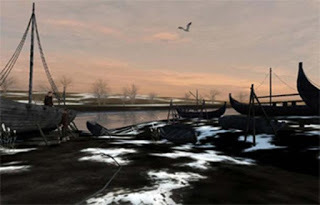
An image from the Museum of Yorkshire virtual reality experience showing Viking ships under repair. ( University of Sheffield )
The press release quotes chief researcher Professor Dawn Hadley of the University of Sheffield Department of Archaeology as saying:
‘The Vikings’ camp at Torksey was much more than just a handful of hardy warriors – this was a huge base, larger than most contemporary towns, complete with traders, families, feasting, and entertainment. From what has been found at the site, we know they were repairing their boats there and melting down looted gold and silver to make ingots – or bars of metal they used to trade. Metal detectorists have also found more than 300 lead game pieces, suggesting the Vikings, including, women and children, were spending a lot of time playing games to pass the time, waiting for spring and the start of their next offensive.’
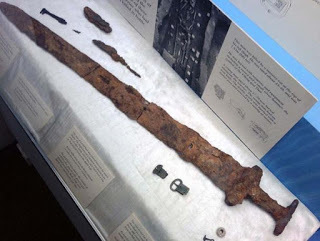
A Viking sword from the same 10-year Viking campaign to conquer England but from a different site. ( CC BY-SA 2.0 )
Metal detectorists and archaeologists have found more than 300 coins and more than 50 pieces of chopped up silver, including brooch fragments and ingots. They have also found rare hack-gold or chopped up gold. Among the coins are 100 Arabic silver coins that researchers assume came to the site from Viking trade routes.
Other artifacts include 300 gaming pieces, spindle whorls, fishing weights, needles and iron tools.
Researchers at the University of York have developed a virtual reality show to give some perspective on what life was like in the Viking army camp. The scenes in the show are based on actual objects that archaeologists and metal detectorists have found at the camp in Torksey. The shows opens today (May 19, 2017) at Yorkshire Museum.
Professor Julian Richards of the Department of Archaeology at the University of York said: “These extraordinary images offer a fascinating snap shot of life at a time of great upheaval in Britain.
“The Vikings had previously often raided exposed coastal monasteries and returned to Scandinavia in winter, but in the later ninth century they came in larger numbers, and decided to stay. This sent a very clear message that they now planned not only to loot and raid – but to control and conquer.”
Top image: Artist’s impression of a Viking camp. ( Vance Kovaks )
By Mark Miller
Published on June 05, 2017 01:30
June 4, 2017
Ancient Shrewsbury sacred site 'oldest of its kind'
BBC
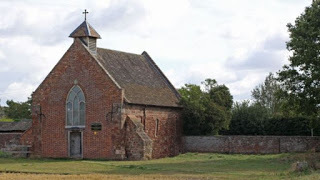
Archaeologists say a sacred burial site uncovered in Shrewsbury in February is over 4,000 years old.
They say the site, which was discovered at a Greek Orthodox Church, may be the country's oldest-known continuously used sacred ground.
Finds suggest it has been used during every era since the late Neolithic period.
Carbon dating of a wooden post extracted during the dig showed it was placed in the ground in 2,033 BC.
Archaeologists expected the post to be Anglo-Saxon.
Other finds on the Oteley Road site included a calf, a pig and a dog that died while giving birth.

Archaeologists initially thought this 4,000 year old post might have been Anglo-Saxon
"The dates have shocked us all," said lead archaeologist Janey Green.
"It appears the current Medieval church is built over the site of an ancient pagan burial ground that's been in use from the late Neolithic period through the Bronze Age, Iron Age, Roman, Anglo-Saxon and through to today.
"The only other British site of a Christian church that is known to date back to the late Neolithic period is at Cranborne Chase, in Dorset, but it is a Norman ruin."
The church was bought by the Greek Orthodox Church from the Church of England in 1994, and archaeologists began investigating after Shropshire Council gave consent for housing in the area.
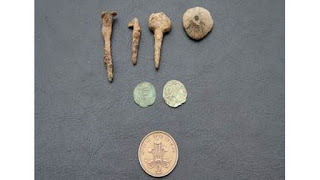
Garment pins have been found at the site
Father Stephen Maxfield, the church priest, said: "Who would have thought that this little church [would turn] out to have a history of great significance?
"From the moment we first saw this building as a crumbling ruin... we thought it was a very special building. Now we know that it is."

Archaeologists say a sacred burial site uncovered in Shrewsbury in February is over 4,000 years old.
They say the site, which was discovered at a Greek Orthodox Church, may be the country's oldest-known continuously used sacred ground.
Finds suggest it has been used during every era since the late Neolithic period.
Carbon dating of a wooden post extracted during the dig showed it was placed in the ground in 2,033 BC.
Archaeologists expected the post to be Anglo-Saxon.
Other finds on the Oteley Road site included a calf, a pig and a dog that died while giving birth.

Archaeologists initially thought this 4,000 year old post might have been Anglo-Saxon
"The dates have shocked us all," said lead archaeologist Janey Green.
"It appears the current Medieval church is built over the site of an ancient pagan burial ground that's been in use from the late Neolithic period through the Bronze Age, Iron Age, Roman, Anglo-Saxon and through to today.
"The only other British site of a Christian church that is known to date back to the late Neolithic period is at Cranborne Chase, in Dorset, but it is a Norman ruin."
The church was bought by the Greek Orthodox Church from the Church of England in 1994, and archaeologists began investigating after Shropshire Council gave consent for housing in the area.

Garment pins have been found at the site
Father Stephen Maxfield, the church priest, said: "Who would have thought that this little church [would turn] out to have a history of great significance?
"From the moment we first saw this building as a crumbling ruin... we thought it was a very special building. Now we know that it is."
Published on June 04, 2017 01:30
June 3, 2017
Cartouche of the Last Pharaoh of Egypt Found at Illegal Dig Under Home in Abydos
Ancient Origins
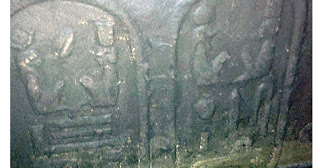
A team of Egyptian archaeologists found a cartouche of the last native Egyptian pharaoh under the home of a man in Abydos, Egypt. The man and his accomplices were doing an illegal excavation underneath the old mud-brick home.
A cartouche or carved stone relief gives the name and epithets of ancient Egyptian kings. In this case it was King Nectanebo II, who ruled during the very end of the 30th Dynasty, 360 to 342 BC.
The team found the cartouche under the home in the Beni Mansour area of Abydos during an inspection. The archaeological committee is from the Al-Belinna inspectorate.
Agents of the Tourism and Antiquities Police have confiscated the home until the committee can complete its investigation, Hani Abul Azm told AhramOnline. He is the chief of Upper Egypt’s Central Administration for Antiquities. He said the cartouche, which is a stone block, could have formed part of the king’s royal shrine or been the extension of a temple wall constructed on the king’s orders.
AhramOnline says Nectanebo II is famous for his construction undertakings in Abydos.
Egypt prospered under the Nectanebo II’s reign. His artists’ distinctive style was unique during the Ptolemaic kingdom. Nectanebo II was inspired by many cults of Egypt’s gods. He left his mark on more than 100 sites, including beginning the huge temple of Isis.
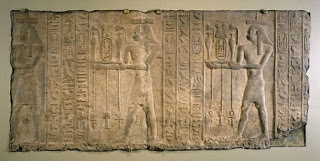
A relief from the time of Nectanebo II’s reign showing gods carrying flowers and drinks for the pharaoh. (Creative Commons Attribution-Share Alike 3.0 Unported License)
After authorities expropriate the house, archaeologists will undertake more excavations under it, according to Abul Azm.
It’s hard to say if the cartouche, which is partly submerged in water underground, is part of a shrine or temple wall, said Ashraf Okasha, the director-general of Abydos Antiquities. He said the block is 1.4 by 40 cm (0.55 by 15.75 inches).
The archaeological committee found the illegal excavations underway, with a 4-meter-deep (16 ft) pit dug under the home, he said. It was at the bottom of this hole that the cartouche was discovered
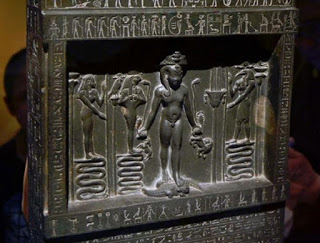
The Metternich Stela, another stone monument from the time of the reign of King Nectanebo II. Photo Source: ( CC BY-NC-SA 2.0 )
Earlier this year, Ancient Origins reported on the spectacular Metternich stela, also created during the reign of King Nectanebo II. Details related to the origins of the artifact remain unknown. It is a part of a group of stelae known as ''Cippus of Horus''- a collection of stelae used to protect people from dangers like snake or crocodile attacks. However, this particular stela is one of the largest of its kind. It also has some of the best-preserved magical text from its time.
The stela has magical recipes to heal poisons, mostly animal poisons. Legends also say the stela itself has magical powers. Ancient doctors would pour water over the stela and collect it to give it to a person who had been poisoned. The spells discuss different animals, but they especially focus on cats and reptiles. Cats were believed to be animals of gods and goddesses, so they were thought to have the ability to heal every poison. The spell against reptile poison was connected to the serpent demon Apophis. It was thought to force the serpent to vomit when the priest was chanting the spell. At that point the sick person would also vomit - relieving him or herself of the poison. The stela also describes some stories related to deities. In fact, most of the text is dedicated to the story of Horus - who was poisoned but cured.
Top image: The bottom of the cartouche is presently submerged in water. It was found in an ongoing illegal excavation at the bottom of a 4-meter pit in a home in Abydos. Credit: Ministry of Antiquities
By Mark Miller

A team of Egyptian archaeologists found a cartouche of the last native Egyptian pharaoh under the home of a man in Abydos, Egypt. The man and his accomplices were doing an illegal excavation underneath the old mud-brick home.
A cartouche or carved stone relief gives the name and epithets of ancient Egyptian kings. In this case it was King Nectanebo II, who ruled during the very end of the 30th Dynasty, 360 to 342 BC.
The team found the cartouche under the home in the Beni Mansour area of Abydos during an inspection. The archaeological committee is from the Al-Belinna inspectorate.
Agents of the Tourism and Antiquities Police have confiscated the home until the committee can complete its investigation, Hani Abul Azm told AhramOnline. He is the chief of Upper Egypt’s Central Administration for Antiquities. He said the cartouche, which is a stone block, could have formed part of the king’s royal shrine or been the extension of a temple wall constructed on the king’s orders.
AhramOnline says Nectanebo II is famous for his construction undertakings in Abydos.
Egypt prospered under the Nectanebo II’s reign. His artists’ distinctive style was unique during the Ptolemaic kingdom. Nectanebo II was inspired by many cults of Egypt’s gods. He left his mark on more than 100 sites, including beginning the huge temple of Isis.

A relief from the time of Nectanebo II’s reign showing gods carrying flowers and drinks for the pharaoh. (Creative Commons Attribution-Share Alike 3.0 Unported License)
After authorities expropriate the house, archaeologists will undertake more excavations under it, according to Abul Azm.
It’s hard to say if the cartouche, which is partly submerged in water underground, is part of a shrine or temple wall, said Ashraf Okasha, the director-general of Abydos Antiquities. He said the block is 1.4 by 40 cm (0.55 by 15.75 inches).
The archaeological committee found the illegal excavations underway, with a 4-meter-deep (16 ft) pit dug under the home, he said. It was at the bottom of this hole that the cartouche was discovered

The Metternich Stela, another stone monument from the time of the reign of King Nectanebo II. Photo Source: ( CC BY-NC-SA 2.0 )
Earlier this year, Ancient Origins reported on the spectacular Metternich stela, also created during the reign of King Nectanebo II. Details related to the origins of the artifact remain unknown. It is a part of a group of stelae known as ''Cippus of Horus''- a collection of stelae used to protect people from dangers like snake or crocodile attacks. However, this particular stela is one of the largest of its kind. It also has some of the best-preserved magical text from its time.
The stela has magical recipes to heal poisons, mostly animal poisons. Legends also say the stela itself has magical powers. Ancient doctors would pour water over the stela and collect it to give it to a person who had been poisoned. The spells discuss different animals, but they especially focus on cats and reptiles. Cats were believed to be animals of gods and goddesses, so they were thought to have the ability to heal every poison. The spell against reptile poison was connected to the serpent demon Apophis. It was thought to force the serpent to vomit when the priest was chanting the spell. At that point the sick person would also vomit - relieving him or herself of the poison. The stela also describes some stories related to deities. In fact, most of the text is dedicated to the story of Horus - who was poisoned but cured.
Top image: The bottom of the cartouche is presently submerged in water. It was found in an ongoing illegal excavation at the bottom of a 4-meter pit in a home in Abydos. Credit: Ministry of Antiquities
By Mark Miller
Published on June 03, 2017 02:00
June 2, 2017
Who Pulled the Sword from the Stone? The Truth of the Swords of King Arthur
Ancient Origins

This spring a new movie, King Arthur: Legend of the Sword, is to hit the big screens. Staring Charlie Hunnam as the fabled warrior, the film title suggests that the central theme is Arthur’s legendary sword. It will be interesting to see just how the sword is depicted, considering that previous Arthurian epics have been far from true to the original tales.
The Sword in the Stone
The theme of King Arthur pulling the sword from a stone in order to prove himself worthy to rule is perhaps the most muddled of all the Arthurian legends.
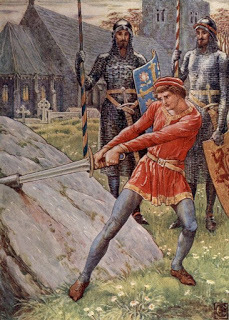
Arthur Draws the Sword from the Stone, by the nineteenth-century English artist Walter Crane. (Public Domain)
To start with, in the original story the sword is stuck in an anvil that rests on a stone—not in the stone itself. And the sword in question is not Excalibur, as commonly believed, but a completely different weapon. The usual setting for the event portrayed by Hollywood is somewhere in the countryside or in a dark forest. However, in the Arthurian romances composed during the Middle Ages, the episode takes place right in the heart of London. The oldest surviving version of the sword and stone story was written by the Burgundian poet Robert de Boron, around the year 1200, who claimed to have taken the theme from a much earlier Dark Age account. According to Robert, the event occurs in the churchyard of “the greatest church in London.”
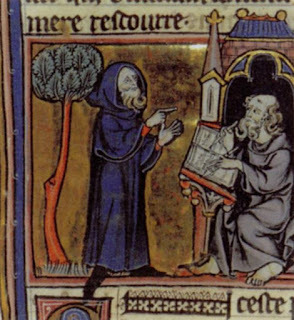
Merlin dictating his prophecies to his scribe, Blaise; French 13th century miniature from Robert de Boron's Merlin en Prose (written ca 1200). (Public Domain)
Since Roman times, the largest and most important church in the British capital has been St. Paul’s Cathedral. Although St. Paul’s went through many periods of reconstruction, culminating with the building we see today, erected in the late 1600s, its location is recorded as having been the seat of the bishops of London since the Romans ruled Britain in the 4th century. As cathedrals were the seats of bishops, it’s certain then that there had been a cathedral on the site, whether or not it was originally dedicated to St. Paul, during the time Arthur is said to have lived— around the year 500.
Surprisingly, an ancient stone really did stand in St. Paul’s churchyard during the Middle Ages that was recorded as being associated with a sword of power. Surviving records dating from as early as eleven hundred years ago refer to the stone as having great ceremonial significance, marking the traditional place where laws were passed and proclamations issued. After 1189, when Henry Fitz-Ailwin became London’s first mayor, the inauguration ceremony expressly required the new incumbent to strike the stone with his sword to validate his entitlement to govern the city. Just how far back the tradition associating the stone with a sword of authority actually goes is unknown, but it certainly existed when Robert de Boron penned his work.
The London Stone
Against all odds, this ancient stone still survives, and local folklore does associate it with King Arthur. Known as the London Stone, it was removed from the churchyard when St. Paul’s was rebuilt after the Great Fire of London in 1666. More recently, and for many years, the stone lay unnoticed and almost forgotten, set into a niche in the wall of a bookstore opposite Cannon Street Station, where it was practically obscured by an iron grille.
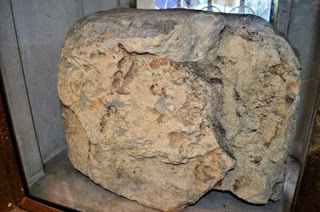
The London Stone. (Photography by Debbie Cartwright)
The building is now being demolished to make way for a new one, and the London Stone has been taken to the nearby Museum of London. The object is a block of limestone, approximately 53 × 43 × 30 centimeters (21 × 17 × 12 inches) in size, the remnant of what was once a somewhat larger item, and the museum has confirmed that the artifact could well be of Roman origin, making it old enough to have been in the cathedral churchyard at the time King Arthur is said to have lived.

The London Stone was hidden away for years behind an iron grille on a busy city street. (Photography by Debbie Cartwright)
The Angles and Saxons
The unusual notion of a sword being stuck in an anvil on top of a stone might be accounted for by an early mistranslation or mix-up of words. Arthur is said to have successfully fought against the invading Anglo-Saxons, originally two separate tribes— the Angles and Saxons— from northern Germany. The Latin word for a rock or large fragment of stone is saxum, a word that sounds very similar to “Saxon.” This, together with the similarity of the name “Angle” and the word “anvil,” might explain how the unusual motif originated. If the legend held that Arthur had “drawn the sword” – in other word, “taken the fight” – from the Angles and Saxons, then at some point during the turmoil following the collapse of the Roman Empire in the 400s, and the subsequent lack of historical records, oral accounts may have become confused. By Robert de Boron’s time, an account of Arthur seizing the initiative from the Angles and Saxons might well have evolved into the story of him drawing a sword from an anvil and stone.
Excalibur
Excalibur is another sword entirely. In the medieval Arthurian tales, Merlin takes Arthur to receive this marvelous weapon from a mysterious water nymph called the Lady of the Lake.

King Arthur asks the Lady of the Lake for the Sword Excalibur, by the nineteenth-century English artist Walter Crane. (Public Domain)
And when the king ultimately lies dying on the field of battle, Excalibur is thrown into an enchanted pool, where the Lady of the Lake catches the weapon and takes it down into the watery depths. This theme probably developed from the ancient Celtic practice of casting prized belongings, such as swords, into sacred lakes and pools as offerings to a water goddess. Archaeologists have uncovered many such objects: for example, from the bed of the dried-up lake of Llyn Cerrig Bach on the island of Anglesey in North Wales. It is thought that warriors’ swords were thrown into such hallowed waters during funerals so as to assure the spirit’s safe passage to the afterlife.

Sir Bedevere Casts the Sword Excalibur into the Lake, by the nineteenth-century English artist Walter Crane. (Public Domain)
A Historical Sword
Perhaps the most common mistake made by Hollywood in the portrayal of Arthur’s sword, be it Excalibur or the one connected with the stone, is to depict it as a long, medieval “arming sword,” commonly, but wrongly, referred to as a broadsword. Around the year 500, the period in which the story of Arthur is set, swords would have been much shorter, with a stunted cross-guard, such as the Roman-style cavalry sword, the spatha.
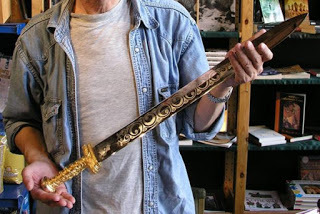
A historical “Excalibur.” Replica of a high-status spatha, a short Roman-style sword possessed by post-Roman British chieftains. (Photography by Debbie Cartwright)
These were basically used for cutting down opponents from horseback, rather than for swordfights as depicted in the movies. The spatha seems to have been adopted as a sword of office by the post-Roman Britons, so if there was an historical Arthur then his sword would most likely have been one of these.
So, when you watch what is promising to be the new blockbuster Arthurian movie, King Arthur: Legend of the Sword, perhaps it would be fun to tick off just how many aspects of the “legend” tie up with the original tales, or the historical period in which the story was first set.
A fuller account of this investigation into the legends of King Arthur can be found on Graham Phillips’ website: grahamphillips.net
And in his book The Lost Tomb of King Arthur ***
Published on June 02, 2017 01:30
June 1, 2017
Say the Magic Word: The Origins of Abracadabra and Other Magical Mutterings
Ancient Origins

Magic words are often used by magicians whilst performing magic tricks on stage. One of the most common of these incantations is ‘Abracadabra’. Although this word is known to many, it is likely that fewer people are aware of its origins. Apart from ‘Abracadabra’ there are several other magic words that are popularly used by stage magicians. Like ‘Abracadabra’, however, the origins of these words are also a mystery to most people.
Religious Roots
Whilst ‘Abracadabra’ is commonly used by stage magicians today for the entertainment of the masses, this word is said to have its origins in the ancient Roman world. Back then, this word was not used for performances, but was believed to contain potent magical power within it. According to one theory, the word ‘Abracadabra’ is derived from the Hebrew words ‘ab, ben, ruach hakodesh’, which translates as ‘Father, Son and Holy Spirit’. Thus, the word ‘Abracadabra’ is in fact an invocation of the Holy Trinity. According to another theory, this magic word is derived from another magic word known as ‘abraxas’. This word is special, as its letters, in Greek numerology, adds up to 365, i.e. the number of days in a year.

Oil sketch for Hone's satirical painting The Pictorial Conjuror, 1775 (Public Domain)
Yet another theory for the origins of the word ‘Abracadabra’ is the Aramaic phrase ‘Avra kadavra’. Fans of the Harry Potter series, would perhaps be familiar with this phrase, as a similar spell, ‘Avada kedavra’ is featured in the books. In the Harry Potter series, ‘Avada kedavra’ functions as a killing curse, and J. K. Rowling, who authored the books, is said to have drawn inspiration for this spell from the original Aramaic version of it. The original meaning of these magical words, according to Rowling, was ‘let the thing be destroyed’, and that it was used for the curing of illnesses.
The Medicinal Charm
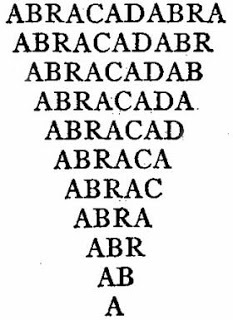
‘Abracadabra’ written in its triangular / pyramidal form. (Public Domain)
In any case, ‘Abracadabra’ was used as a talisman over the ages. The 2nd century Roman savant, Serenus Sammonicus, for instance, provides a description in his Liber Medicinalis about the way this magic word may be used. This talisman involved the word being written on a piece of parchment repeatedly, with a letter being removed each time, until only one is left. The use of this ‘Abracadabra’ pyramid is mentioned by writers in later ages, including the 16th century Eva Rimmington Taylor, and the 18th century Daniel Defoe. Eventually, people stopped believing in the efficacy ‘Abracadabra’, and this word became used by stage magicians for performing magic tricks.

Magic words and signs on a rolled strip of paper (18th century). Upper Austrian County Museum (CC BY-SA 3.0)
Other Magic Words
Another common magic word is ‘Alakazam’. This incantation is said to have its origins in the Arabic language, and it has been pointed out that there is a similar-sounding word in that language, ‘Al Qasam’, which means oath. It has also been suggested that ‘Alakazam’ is a proper name, and that this magic spell was supposed to invoke the powers of a certain person by the name of Alakazam. ‘Hocus Pocus’ is yet another magic word that is often used by magicians. Unlike ‘Abracadabra’, the origin of this magic phrase lies in the more recent past, around the early 17th century, to be more precise. Like ‘Abracadabra’ and ‘Alakazam’, there are several theories trying to explain the origin of this phrase. One, for instance, is offered by John Tillotson, the Archbishop of Canterbury in 1694. Tillotson suggests that this is a corruption of ‘hoc est corpus’, and is a parody of the consecration during the Catholic Mass. Another suggestion is that the words sounded exotic, and this pair of words was coined simply because they rhymed.
In addition to these traditional magic words, there are also many others that have appeared in more recent times. Some of the better-known ones include ‘Bibbidi-Bobbidi-Boo’, used by the Fairy Godmother in Disney’s Cinderella, ‘Shazam’, used by DC Comic’s Billy Batson to transform into the superhero Captain Marvel, and ‘A-la Peanut Butter Sandwiches’, which is uttered by the Amazing Mumford in Sesame Street.
Top image: Ancient Book (CC BY SA 3.0)
By Wu Mingren
References
Conley, C., 2008. Magic Words: A Dictionary. San Francisco, Calif.: Weiser Books.
Martin, G., 2017. Abracadabra. [Online] Available at: http://www.phrases.org.uk/meanings/ab...
Martin, G., 2017. Hocus-pocus. [Online] Available at: http://www.phrases.org.uk/meanings/ho...
Shnidman, R., 2013. Word of the Day Abracadabra: Be Careful What You Wish For. [Online] Available at: http://www.haaretz.com/jewish/feature...
Upton, E., 2013. The Fascinating Origin of the Word “Abracadabra”. [Online] Available at: http://www.todayifoundout.com/index.p...
Published on June 01, 2017 02:00
May 31, 2017
Treasure Hunter that Found Unique Viking hoard to be Awarded £2 Million
Ancient Origins
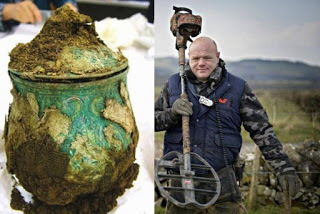
Derek McLennan, a British metal detectorist who unearthed the richest collection of unique Viking artifacts ever found in the UK will receive an astonishing £2 million (US$2.6m) as a reward. The amount is ex gratia and has been set to reflect the market value of the find.
Amateur Treasure Hunter About to Receive 2 Million Pounds for his Discovery
Derek McLennan discovered the 10th-century hoard in a Dumfries and Galloway field (one of 32 unitary council areas of Scotland) in 2014. The incredibly valuable treasure includes silver bracelets and brooches, a gold ring, a bird-shaped gold pin, an enameled Christian cross, and a Carolingian vessel filled with artifacts.
McLennan notified the authorities about his valuable finds and now, three years later, the Queen’s and Lord Treasurer’s Remembrancer (the body that rules on ownerless goods and property), has ruled that the one-hundred unique items of the hoard should be held with National Museums Scotland (NMS) for public display, after offering ex gratia to McLennan, the enormous sum.
In contrast with the rest of the UK, where awards are split with the landowner, rules on discoveries in Scotland reward only the finder who receives the whole payment and now NMS has six months to raise the funds. Dr. Evelyn Silber, University of Glasgow’s honorary professorial research fellow in History of Art and Safap chair, told The Guardian, “The panel is grateful to the finder for reporting these stunning artefacts which include decorative glass beads, silver bracelets and brooches, a gold ring, a bird-shaped gold pin and a highly-decorated gilt vessel recognized as being one of only three known examples. These will now be preserved and put on display for the people of Scotland, and the world, to enjoy.”
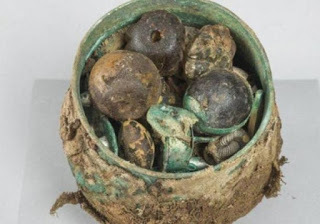
The Carolingian vessel filled with artifacts. (Historic Environment Scotland)
The Discovery of the Hoard
But how did Derek McLennan end up discovering the richest Viking hoard in British history? Was it pure luck or did he knew something? As April Holloway reports in a 2014 Ancient Origins article, McLennan used a metal detector on Church of Scotland land when he picked up a signal indicating the presence of metal beneath the ground. He dug down some 24 inches (60cm) before finding the first item. As soon as Derek recovered the first arm-ring he realized the significance of his find and contacted the Scottish Treasure Trove Unit. They sent an experienced archaeologist, Andy Nicholson and the hoard was excavated properly.
What’s interesting, however, is that the Church of Scotland, which owns the land where the treasure was found, reached an agreement with McLennan back then about the equitable sharing of any proceeds that he would be awarded and now it’s unknown whether McLennan will honor this agreement with the Church of Scotland, or if he will claim the rules of Scotland as we already mentioned before, which rewards only the finder of the treasure.
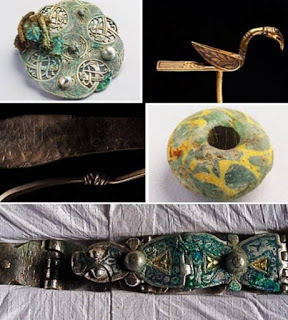
Some of the treasures: A silver disk brooch decorated with intertwining snakes or serpents (Historic Scotland), a gold, bird-shaped object which may have been a decorative pin or a manuscript pointer (Robert Clark, National Geographic / Historic Environment Scotland), one of the many arm rings with a runic inscription (Robert Clark, National Geographic / Historic Environment Scotland), a large glass bead (Santiago Arribas Pena), and a hinged silver strap (Robert Clark, National Geographic / Historic Environment Scotland).
Hoard is of International Significance
David Harvie, the Queen’s and Lord Treasurer’s Remembrancer, described the Galloway hoard as globally remarkable and one of the most important finds ever discovered in Scotland. “I am pleased to announce that I am minded to accept the recommendation of the Scottish Archaeological Finds Allocation Panel [Safap] that these wonderful items be allocated to National Museums Scotland, subject to it meeting the ex gratia award which would then be payable to the finder,” he told The Guardian.
Dr. Gordon Rintoul, director of NMS, appears to be grateful in his statements as The Guardian reports, “The Galloway hoard is of outstanding international significance and we are absolutely delighted that QLTR has decided to allocate it to NMS. We now have six months to raise £1.98m to acquire this unique treasure for the nation and ensure it can be enjoyed by future generations both at home and abroad.”
Additionally, NMS stated that several other finds from the UK and Ireland have been remarkable as well, but the Galloway hoard offers an incredible variety of objects, revealing previously unknown relationships between European nations in the 10th century, a fact that opens new horizons of study and research on the matter.
Top image: Left: Large silver alloy Carolingian vessel, which was part of the hoard. Right: Derek McLennan, the finder of the treasure hoard. Photograph: Jamie Simpson
By Theodoros
Published on May 31, 2017 02:30
May 30, 2017
Does the Fierce Reputation of The Picts Reflect Reality?
Ancient Origins

It’s not that the Picts, a group of British Isle inhabitants, were that different from native Britons around the fourth century, a historian suggests in a new book. It’s just that Julius Caesar didn’t conquer them.
The often mischaracterized, always mysterious people could serve as a historical laboratory to explore how the island’s culture might have developed without Roman intervention.
Although the Picts’ legacy stretches back centuries before that first encounter with Rome, the group entered the historical record as Roman forces began to push their empire’s frontiers into northern England.
Roman Occupation
By the fourth century AD, Romans typically referred to the fierce warriors who lived north of Hadrian’s Wall—Rome’s nearly 80-mile long defensive line in England—as the Picts.

Part of Hadrian's Wall running downhill from the northeast corner of Housestead’s Roman Fort. (Public Domain)
“The big myth is that the Picts were somehow different from the native Britons, the people that Julius Caesar met when he came over to England,” says Benjamin Hudson, professor of history and medieval studies at Penn State and author of The Picts (Wiley Blackwell 2014).
“They weren’t different—they were merely Britons that the Romans didn’t conquer.
One of the many neglected aspects of Pictish society is what it can tell the historian—one of the questions we have about what happened after the Roman occupation of southern Britain is why the Britons reverted so quickly to the type of organization they had prior to the Romans. I
f you look at the Picts you find that the identity and the organization of the Picts is similar to southern Britain after the Romans left, but Roman writers weren’t interested in that part of history.”
Warriors or Victims?
Throughout history, the Picts have often suffered from the biases of the times, which led to the overgeneralization of their society. Roman historians portrayed the Picts as warriors and savages.

Hand-colored version of Theodor de Bry’s engraving of a Pict woman (a member of an ancient Celtic people from Scotland). De Bry’s engraving, “The True Picture of a Women Picte,” 1588 (Public Domain)
The name Pict is a pejorative from a Latin term for picture. The Picts used body art, something that horrified and intimidated the invading Romans. More recent historians may have created an image of the Picts as helpless victims of progress and warfare.
The truth, according to Hudson, is probably much more nuanced.
As much as they are known for their body art, the Picts are also known for the variety and quantity of sculpture and artwork that they left, a proficiency that defies their early reputation as uncivilized warriors.
“They have almost as many monuments as does the area south of Hadrian’s Wall,” Hudson says. “Some of these are miniature on the Stonehenge model, standing stones. Some of them are in burial mounds made in concentric circles.”
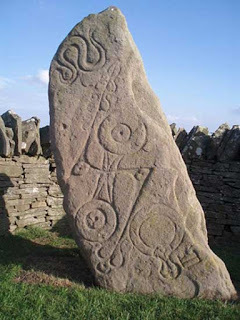
Serpent Stone, Pictish monument engraved with symbolism Aberlemno, Scotland (CC BY-SA 3.0)
That is only one of the mysteries of Pict sculpture, however. The monuments are adorned with symbols that have yet to be translated.
“Despite claims to the contrary, nobody has yet come up with a translation of the Pictish symbols that satisfies everybody else,” Hudson says. “Are we looking at pictographs or are we looking at something from more of a Scandinavian context?”
The Scots, who eventually invaded the territory controlled by the Picts in the mid-ninth century AD, eventually absorbed the people into their own culture.
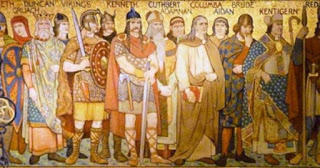
Detail from a frieze in the Scottish National Portrait Gallery, Queen Street, Edinburgh. (rampantscotland.com)
“The Picts didn’t go out with so much of a bang as they went out with a whimper,” Hudson says. “When the Scots King Kenneth McAlpin moved his troops from western Scotland to eastern Scotland, we find that he amalgamated the Pictish people he found there and suddenly they took on the name of their conquerors. For a time, they were called the Picts, and then Scot-Picts and then, eventually, just Scots.”
Source: Penn State University
The article ‘How The Picts Got Their Fierce Reputation’ by Matthew Swayne Penn State University was originally posted on Futurity and has been republished under a Creative Commons license.
Top Image: Saint Columba converting King Brude of the Picts to Christianity, Scottish National Portrait Gallery (CC BY-SA 3.0)
Published on May 30, 2017 02:00
May 29, 2017
Memorial Day 2017: A Day to Remember the sacrifices of our Armed Forces
 Wikipedia
WikipediaMemorial Day is a federal holiday in the United States for remembering the people who died while serving in the country's armed forces. The holiday, which is currently observed every year on the last Monday of May, originated as Decoration Day after the American Civil War in 1868, when the Grand Army of the Republic, an organization of Union veterans founded in Decatur, Illinois, established it as a time for the nation to decorate the graves of the Union war dead with flowers. By the 20th century, competing Union and Confederate holiday traditions, celebrated on different days, had merged, and Memorial Day eventually extended to honor all Americans who died while in the military service.
Published on May 29, 2017 02:00
May 28, 2017
Featured Author - Mary Anne Yarde

Mary Anne Yarde
Author of the best selling Du Lac Chronicles series.
Born in Bath, England, Mary Anne Yarde grew up in the southwest of England, surrounded and influenced by centuries of history and mythology. Glastonbury--the fabled Isle of Avalon--was a mere fifteen-minute drive from her home, and tales of King Arthur and his knights were part of her childhood.
At nineteen, Yarde married her childhood sweetheart and began a bachelor of arts in history at Cardiff University, only to have her studies interrupted by the arrival of her first child. She would later return to higher education, studying equine science at Warwickshire College. Horses and history remain two of her major passions.
Yarde keeps busy raising four children and helping run a successful family business. She has many skills but has never mastered cooking--so if you ever drop by, she (and her family) would appreciate some tasty treats or a meal out!
Five things you didn’t know about me!!

I am scared of heights.

When I was seven, my school thought it would be fun if we dressed up as nursery rhyme characters for ‘Book Week.’ I dressed up as Mary Had A Little Lamb — I know, how original! I did however bring a real life lamb with me — no one else thought of doing that, did they?! It meant I spent the day in the school playing field, as the lamb was not allowed inside the school building. So if you ever want to get out of school, I recommend bringing a sheep with you, it works every time!

I once slept in an aircraft hanger ~ don’t ask!

I once slept on the floor of a convent ~ again, don’t ask!
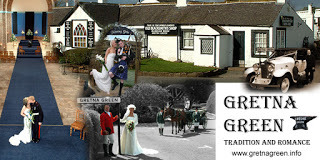
I got married at Gretna Green.
Novels
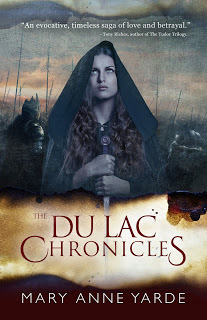
The Du Lac Chronicles
A generation after Arthur Pendragon ruled, Briton lies fragmented into warring kingdoms and principalities.
Eighteen-year-old Alden du Lac ruled the tiny kingdom of Cerniw. Now he half-hangs from a wooden pole, his back lashed into a mass of bloody welts exposed to the cold of a cruel winter night. He’s to be executed come daybreak—should he survive that long.
When Alden notices the shadowy figure approaching, he assumes death has come to end his pain. Instead, the daughter of his enemy, Cerdic of Wessex, frees and hides him, her motives unclear.
Annis has loved Alden since his ill-fated marriage to her Saxon cousin—a marriage that ended in blood and guilt—and she would give anything to protect him. Annis’s rescue of Alden traps them between a brutal Saxon king and Alden’s remaining allies. Meanwhile, unknown forces are carefully manipulating the ruins of Arthur’s legacy.
Amazon US
Amazon UK

The best-selling Du Lac Chronicles continues:
War is coming to Saxon Briton.
As one kingdom after another falls to the savage might of the High King, Cerdic of Wessex, only one family dares to stand up to him — The Du Lacs.
Budic and Alden Du Lac are barely speaking to each other, and Merton is a mercenary, fighting for the highest bidder. If Wessex hears of the brothers’ discord, then all is lost.
Fate brings Merton du Lac back to the ancestral lands of his forefathers, and he finds his country on the brink of civil war. But there is worse to come, for his father’s old enemy has infiltrated the court of Benwick. Now, more than ever, the Du Lac must come together to save the kingdom and themselves.
Can old rivalries and resentments be overcome in time to stop a war?
The Du Lac Devil is a standalone novel and has a recommend reading age of 16+
Amazon US
Amazon UK
Published on May 28, 2017 02:00



